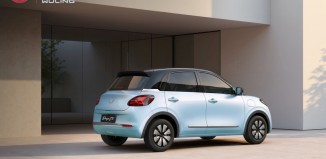Citroen C5 Goes on Sale
Following its Asian debut at the KL International Motorshow late last year, Directional (Malaysia) Sdn Bhd yesterday officially introduced Citroen’s flagship – the C5.
Typical of Citroen models, the C5’s styling takes on a different and less conventional approach than most other sedans. Its lines are aerodynamic with a blend of wedged profile and rounded edges.
Dimensionally comparable to the XM which served as Citroen’s flagship during the 1990s, the C5 is significantly larger than the Xantia and measures 4.62 metres long and 1.77 metres wide, as well as almost 1.5 metres high.
Citroen’s stylists at the Velizy Styling Centre in France have always been skilled at creating bodystyles that are a combination of hatchback and sedan in a sleek profile. They have been just as successful with the C5 which has the look of a 3-box sedan and yet is a more versatile hatchback. If it matters to you, the Cd is 0.29.
Technically, the C5 is advanced and packed with a number of innovations. Among the highlights is the Hydractive 3 suspension system, an evolution of Citroen’s proven hydraulic suspension system. The latest generation has enhanced performance through using electronics with the ‘brains’ of the system being the Built-In Hydroelectronic Interface (BHI).
The BHI incorporates a powerful ECU, an autonomous hydraulic pressure generator and an electric motor. It provides automatic ride height adjustment (three levels) depending on road speed and also surface conditions. Additionally, the damping is adaptive and firms up for sharper handling but can also change to a more comfortable mode at lower speeds. If desired, the driver can manually choose the sporty mode.
So confident of the Hydractive 3 system (which uses a fully-synthetic fluid) after extensive testing, Citroen says that it needs no maintenance for five years or 200,000 kms.
The Hydractive 3 system is an integral part of the suspension system which comprises independent MacPherson struts in front which are located with forged steel wishbones, and an innovative rear suspension layout with cast iron trailing arms, self-steering elastic bushes and a stabilizer. The trailing arms are linked by a light cross-beam with an aluminium section.
Another advancement in the C5: multiplexing of the electrical systems. This is the way many manufacturers are going in view of the rapid increase in electronics inside a car. The various systems need to communicate with each other; in the past, linking them meant running kilometres of wiring around the bodyshell, adding weight and complexity. Multiplexing in the C5, besides increasing reliability, reduces this by 30% and uses four separate and interdependent networks to link 20 modules via the Built-In Systems Interface (BSI) which is the management system.
At this time, Citroen offers petrol and diesel engines for the C5 and the one chosen for the Malaysian market is the EW10J4 unit. This is, however, not the direct-injection version of the EW family which is coded ‘EW10D’. The EW10J4 is a 4-cylinder engine with twin cams and 4 valves per cylinder. Already in use in other Citroen models, the engine has multipoint fuel injection and in updated form for the C5, its weight has been lowered by 27 kgs. It is also said to have less internal frictional losses and a more optimised combustion chamber as well as air intake line.
The undersquare (85 mm bore, 88 mm stroke) engine has a displacement of 1997 cc and on a compression ratio of 10.8:1, maximum power output is 100 kW/138 bhp at 6000 rpm with maximum torque of 190 Nm at 4100 rpm. A look at the torque curve shows that 170 Nm is available from as low as 1800 rpm, suggesting good flexibility.
An advanced 4-speed automatic transmission is used, this being manufactured jointly by the PSA Peugeot-Citroen group and Renault. The transmission is conceptually like a tiptronic unit, offering the driver manual (sequential) shifting or fully automatic changes.
The 463-kg body structure is very strong and designed to protect the occupants during accidents. It’s the first Citroen to feature six airbags as standard equipment, two of which are side curtain bags dropping from above the windows during a side impact.
Apart from this high level of passive protection, the C5 also comes with much active safety in the form of ABS with EBD (Electronic Brake Force Distribution) for all four disc brakes. Emergency braking aids and automatic engagement of the hazard warning lights are also included. All modern brake systems have booster systems to multiply brake force through the hydraulic system but Citroen uses the term “amplifier” although no explanation is available whether this is the same thing.
Standard equipment in the units on display at Directional Malaysia appeared to be very comprehensive and not unexpectedly, the cabin has an aura of luxury. There’s a classy fabric upholstery with wood trim on the dashboard and the aluminium sill finishers add a touch of class too.
Priced at around RM163,000 with 100% insurance premium and a year’s roadtax, the C5 imported for the Malaysian market is the 2.0-litre 16-valve variant with an automatic transmission. Directional Malaysia is targetting to sell at least 50 units a month. There are no plans to assemble the model locally, though.
























